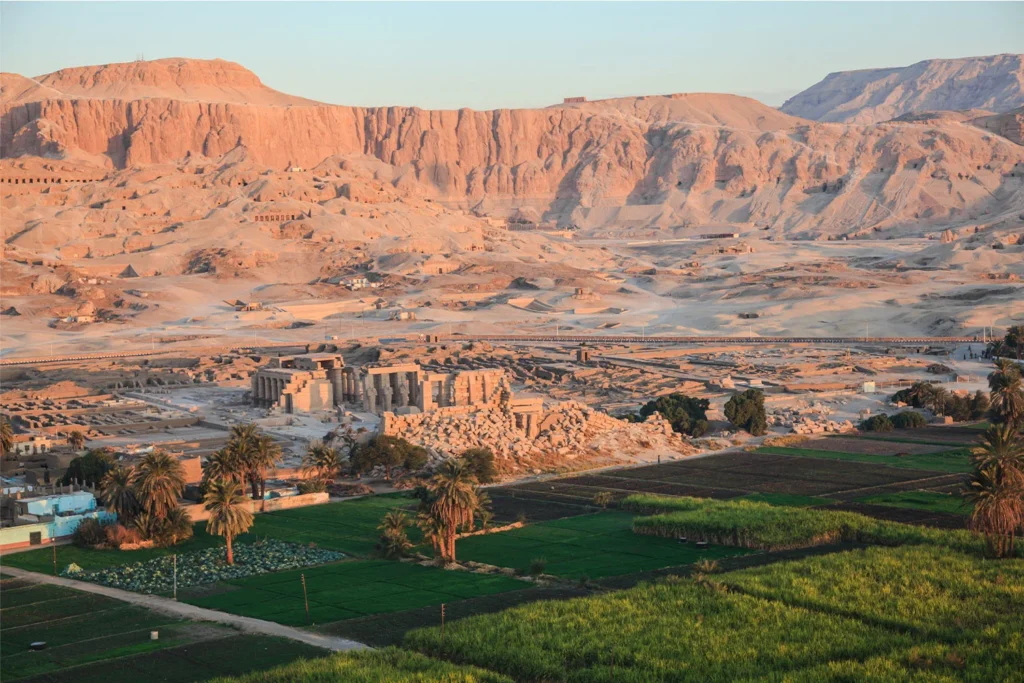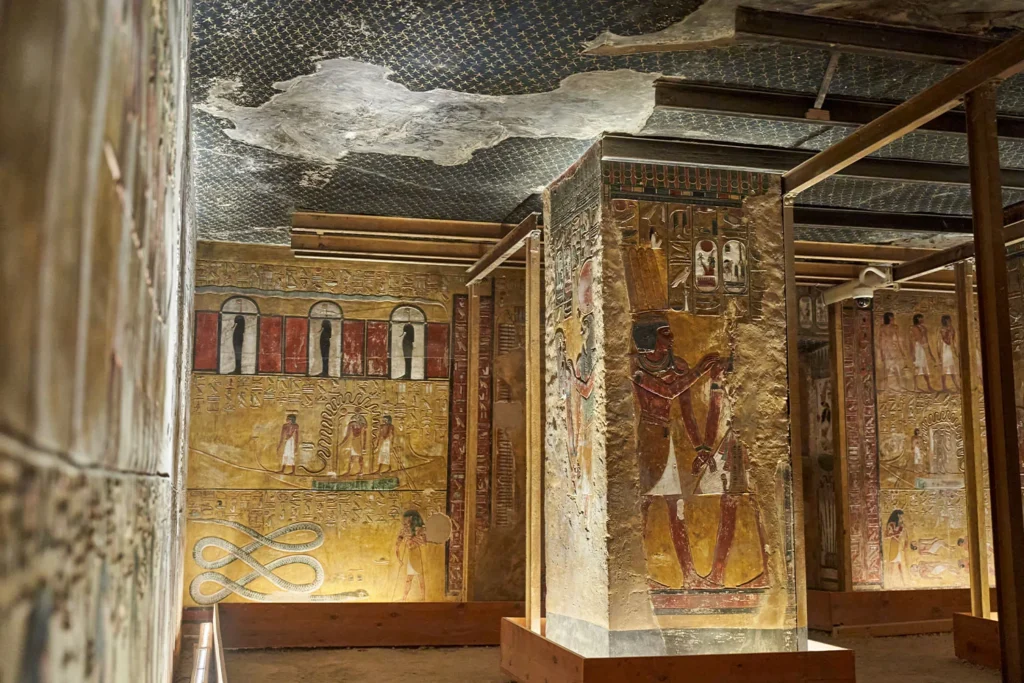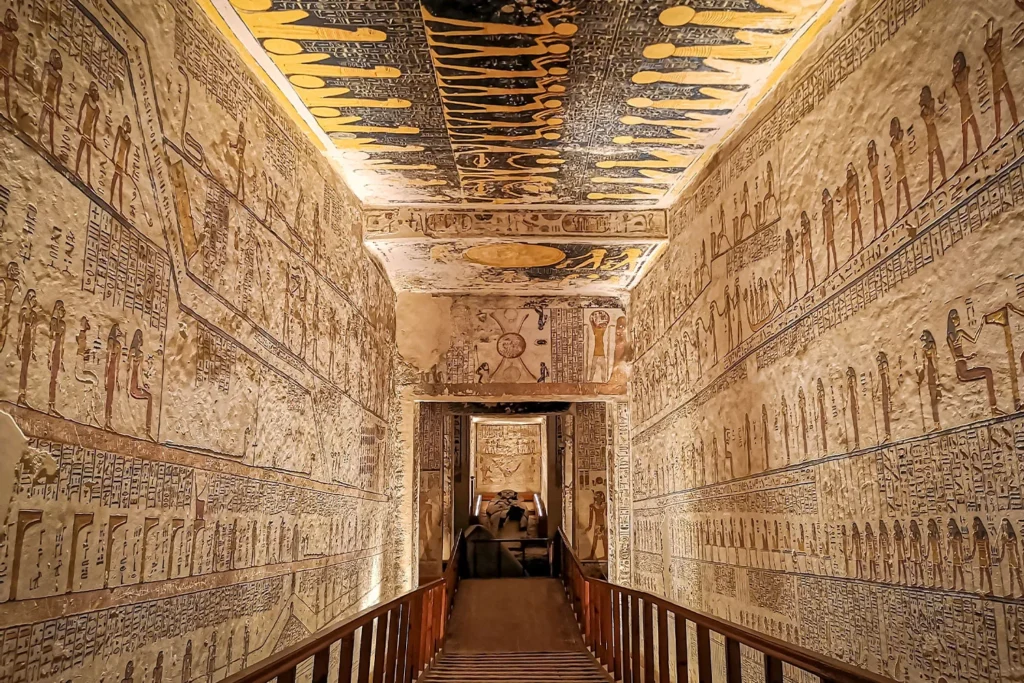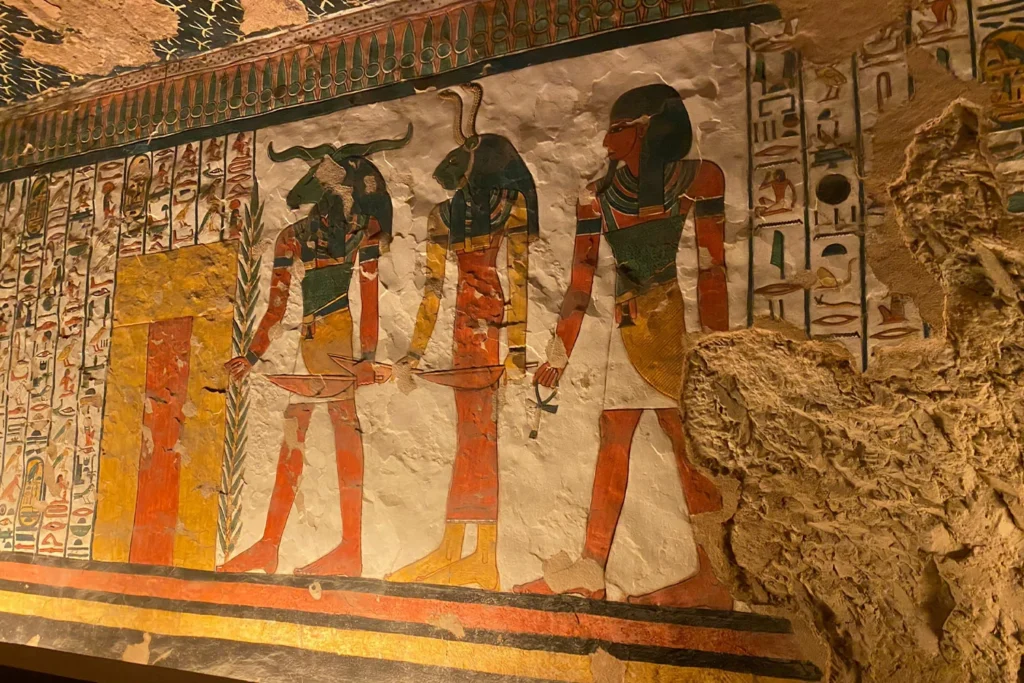Today, the time machine takes us back to the era of fascinating rituals, hieroglyphs, and all-powerful pharaohs. We begin our journey to the gates of one of Egypt’s most prominent landmarks, shedding new light on one of the most captivating ancient civilizations.
The Valley of the Kings is a long canyon in Upper Egypt, serving as the burial site for most of the pharaohs who ruled ancient Egypt between 1539-1075 BCE (belonging to the 18th, 19th, and 20th dynasties). The valley lies on the western bank of the Nile, opposite modern Luxor, and is carved into the Theban Hills. Why is this location such a significant attraction for tourists? It’s time to learn more about the Valley of the Kings and uncover the secrets of one of the most powerful civilizations in world history.
How was the Valley of the Kings discovered?
Some sources, such as maps created by members of Napoleon’s expedition to Egypt, clearly indicate that the Valley of the Kings was noted earlier. However, it is officially believed that the first tomb was discovered in 1817 by Giovanni Battista Belzoni, an Italian explorer. It was he who uncovered the impressive tomb of Seti I in the Valley of the Kings.
He was incredibly fortunate to stumble upon one of the most breathtaking crypts. At the end of his excavation efforts, Belzoni officially declared that the valley no longer concealed anything noteworthy. Little did he know how wrong he was. In the latter half of the 19th century, the Egyptian Antiquities Service resumed investigations. They gradually uncovered more tombs, but nothing sparked such global awe as the discovery of the royal tomb of Tutankhamun in 1922.
Modern History of the Valley of the Kings
In 1979, the Valley of the Kings was added to the UNESCO World Heritage List, which significantly boosted tourist interest. Visitors flocked to the gates of the valley to uncover its priceless ancient treasures. Unfortunately, by the late 20th century, the fragility of the royal burial chambers became increasingly evident, exacerbated by floods and pollution.

In order to protect this site at all costs, the Valley of the Kings was included in the World Monuments Watch program in 2000 and 2002. It was likely thanks to the funds obtained through this program that we can still marvel at the wonders of ancient Egyptian culture today. This initiative helped raise awareness about the impact of tourism on the site and led to significant improvements in signage and conservation methods.
A Place Chosen by the Gods
The Valley of the Kings was chosen as the burial site for most of the rulers of Egypt’s New Kingdom for several significant reasons. Why this location? There were multiple factors. The valley was just a kilometer away from the temples and villages of the Theban people, and the mountain casting shade over the valley, now known as Qurn (meaning “horn” in Arabic), resembled a pyramid—a form strongly associated with the sun god Re and long connected with royal burials. The ancient Egyptians believed that the gods had selected this spot as the eternal resting place for their kings.

As with most ancient Egyptian cemeteries, this one had to be situated on the western bank of the Nile. Egyptians believed the sun god died on the western horizon each day only to be reborn in the east, so the west was closely linked with funerary rituals. The valley’s small size and surrounding steep limestone cliffs also worked in its favor. Its isolated position made it more difficult to access, providing natural protection, and it was thought to be easier to guard against tomb robbers.
Visiting the Valley of the Kings
It’s important to note that there are actually two Valleys of the Kings: the Eastern Valley, which is the most famous and attracts the majority of tourists due to the large number of royal tombs, and the Western Valley, which covers a larger area but is lesser known and contains only two royal tombs.
The Valley of the Kings contains 64 numbered tombs, each marked with the symbol “KV” (for King’s Valley), where kings, members of the royal family, and high officials were buried. You will encounter both small burial pits for nobles as well as massive tombs resembling labyrinths, where one could easily get lost. The walls of many tombs are adorned with intricate hieroglyphs and decorations, often depicting gods and illustrating themes important to ancient Egyptian culture. In some of the tombs, you can still see sarcophagi or mummies. Equally significant are the treasures found within these burial chambers, which provide invaluable insights into the lives and culture of the ancient Egyptians.
Choosing the most beautiful tombs to visit is a matter of personal preference. Some might be drawn to the uniqueness of the decorations, others to the remarkably preserved paintings, and still others to the architectural features of the tombs. To help you decide, here’s a brief guide to this remarkable necropolis.
Tomb of Seti I (KV17)
Seti I, the second king of the 19th Dynasty and father of the more famous Ramesses II, rests in one of the largest and most impressive tombs in the Valley of the Kings. Also known as “Belzoni’s Tomb,” after its discoverer Giovanni Battista Belzoni, it was the first major tomb unearthed in the valley and remains a highlight for many visitors. While it may attract tourists due to its early discovery, the real draw lies in the stunning decorations that adorn its walls. The Tomb of Seti I was the first fully decorated tomb in the Valley of the Kings. The intricate funerary texts were meant to ensure the pharaoh’s successful journey into the afterlife, while the vivid paintings and reliefs commemorate the king’s achievements and moments from his life.

A labyrinth of corridors, passages, and chambers leads to the burial chamber itself. Along the way, one room was intentionally designed as a decoy, meant to mislead tomb robbers into believing they had reached the actual burial site.
FUN FACT: In 1821, Giovanni Belzoni, the tomb’s discoverer, organized an exhibition at the Egyptian Hall in Piccadilly, London, displaying painted reconstructions of several rooms from the tomb. This exhibition is said to have sparked widespread interest and fascination with ancient Egyptian culture and history.
Tomb of Tutankhamun (KV62)
The discovery of Tutankhamun’s tomb in 1922 by British archaeologist Howard Carter made headlines worldwide and remains one of the most iconic finds in the history of archaeology. It is the only tomb in the Valley of the Kings that was never robbed, allowing most of its treasures to remain perfectly intact. The stunning collection of artifacts uncovered in this tomb has since become synonymous with the grandeur of ancient Egypt, making the discovery one of the most significant in history.

In comparison to the grander tombs of other pharaohs, Tutankhamun’s burial chamber is relatively modest in both size and decoration. Only the walls of the burial chamber are adorned, featuring a few depictions of the young king alongside various deities. Unlike the richly inscribed tombs of other royals, Tutankhamun’s tomb lacks detailed funerary texts. However, what it lacks in decoration, it more than compensates with the sheer volume of treasures—around 5,000 artifacts were found inside, including clothing, cosmetics, jewelry, incense, furniture, and even toys, as the boy-king ascended the throne at just nine years old. These objects offer a glimpse into the lavish lifestyle of the royal palace and the daily life of the young pharaoh.
Tutankhamun’s legacy is one of history’s greatest ironies. Though a relatively minor ruler in ancient Egypt, reigning for only about nine years, his name has far surpassed many of Egypt’s most powerful kings in fame. The discovery of his tomb left the world wondering just how much greater the riches of more prominent rulers like Thutmose III or Ramesses II must have been before their tombs were looted.
The Curse of Tutankhamun
Shortly after the discovery of Tutankhamun’s tomb, several people involved in the excavation began to die under mysterious circumstances. This quickly led to the rise of the famous “Curse of the Pharaohs,” believed to have fallen upon those who dared disturb the eternal rest of Egypt’s kings. This notion sparked numerous legends, later immortalized in books and films. However, there is a more scientific, and much more plausible, explanation for the phenomenon. The tomb, sealed for centuries, contained decaying human matter, food, plants, and other organic material, which helped preserve a multitude of bacteria and viruses. When the tomb was opened, these microorganisms were released, causing health complications for those present—not a supernatural curse.
Tomb of Ramesses IX (KV6)
Known for its richly decorated walls, the tomb of Ramesses IX is one of the most frequently visited tombs in the Valley of the Kings. It is likely the last royal tomb in which the decorative work was fully completed. The tomb boasts one of the largest entrances in the Valley, with walls adorned with depictions of gods, ritual scenes, and the pharaoh’s vanquished enemies.
What also draws curious visitors to this tomb is the presence of over fifty pieces of graffiti, written in Latin and Greek. These are believed to have been left by ancient tourists. Even more of these inscriptions can be seen in the tomb of Ramesses V and Ramesses VI (KV9).
Other Tombs in the Valley of the Kings
The tombs described above are just a small part of the vast necropolis found in the Valley of the Kings. While it is impossible to detail every tomb, this does not mean the others are any less worthy of attention.
Visitors should also explore the tomb of Ramesses II, the most powerful pharaoh of ancient Egypt, the elegant crypt of Amenhotep II, and the tomb of Merenptah, whose mummy was protected by four sarcophagi. Don’t forget Ramesses III’s tomb, whose side chambers are decorated with paintings of foreign objects like harps and boats, showcasing the richness of Egyptian culture and foreign influence.
The Western Valley of the Kings
Is it worth the effort to explore the less famous part of the Valley of the Kings? If you dislike crowds and have extra time to spare, then the answer is a resounding yes. The peaceful solitude of the Western Valley is a refreshing contrast to the busier Eastern Valley. Four tombs have been discovered in this area, with two identified as royal tombs: the tomb of King Amenhotep III (WV22) and the star of the Western Valley, the tomb of King Ay (WV23). While smaller in comparison to the more famous tombs in the neighboring Eastern Valley, Ay’s tomb is known for its distinctive paintings of baboons and other monkeys. Archaeologists even found mummified baboons inside the tomb, earning this section of the valley the nickname “Valley of the Monkeys.”
The Valley of the Queens
The Valley of the Kings isn’t the only royal necropolis in the area. Just over a kilometer to the west lies another royal valley—the Valley of the Queens, discovered by Ernesto Schiaparelli and Francesco Ballerini in the early 20th century. Over 100 tombs have been found here, the resting places of the wives of Egyptian kings and some princes. All these tombs are marked with the symbol QV (for Queen’s Valley).
It’s not entirely clear why this location was chosen for the burials of queens and children. Perhaps the proximity to the Valley of the Kings was a key factor, or it could have been the presence of a sacred cave dedicated to the goddess Hathor at the valley’s entrance, likely linked to a ritual of rejuvenation for the deceased.

Many of the tombs in the Valley of the Queens have suffered damage and do not retain much of their original grandeur, but there are a few exceptions. If you visit, don’t miss tomb QV66, the burial place of Queen Nefertari, wife of Ramesses II. The vibrant decorations depict scenes from the Book of the Dead, along with images of Nefertari offering gifts to and interacting with gods. Other well-preserved tombs include QV55 and QV44, belonging to the sons of Ramesses III.
So Much to Discover!
Many believed that the 62 tombs discovered before 1922 were all that the mysterious valley had to offer. Then, British archaeologist Howard Carter’s monumental discovery stunned the world. Could the valley still hide more secrets?
So far, 64 tombs have been uncovered in the Valley of the Kings, but few consider this the final count. For instance, the tomb of Ramesses VIII remains undiscovered, and many are convinced it still lies hidden within the valley’s remote corners. No one can be sure how many more tombs await discovery. There could be dozens of crypts still concealed, holding treasures, intricately decorated chambers, and mysterious passageways. Who knows, maybe one of them still protects a wealth as immense as the treasures found in Tutankhamun’s tomb?
Useful Tips
The best way to reach the Valley of the Kings is by car (which you can rent via the RentalCars service), a hired taxi, or a bus through an organized tour that you can book on GetYourGuide. These tours often include visits to nearby attractions such as the Valley of the Queens, the Karnak Temple, or the magnificent Temple of Hatshepsut.
Basic entrance tickets to the Valley of the Kings can be purchased at the ticket counter, though it’s recommended to buy them online in advance. A standard ticket grants access to three of the ten tombs currently open to the public. If you wish to explore more wonders of ancient Egypt, you’ll need to pay extra for each additional tomb. Separate tickets are also required to enter the tombs of Tutankhamun, Seti I, Ramesses V and VI, and Ay, as they are not included in the basic ticket. Additionally, you’ll need to purchase a permit if you want to take photographs with a professional camera or video equipment. However, this is not required for photos taken with a smartphone.
Is there a specific tomb you’re eager to visit? Be sure to check in advance that it’s open to avoid disappointment. If conservation work is required in any of the tombs, they are closed to tourists. The good news is that when one tomb closes for maintenance, another, usually inaccessible tomb, may be opened to the public.
Practical information
- It is best to purchase tickets for the Valley of the Kings in advance. This way, you can avoid standing in long lines and reduce the risk of tickets being sold out.
- Address: Luxor, Luksor 1340420, Egypt
- Buy tickets on GetYourGuide